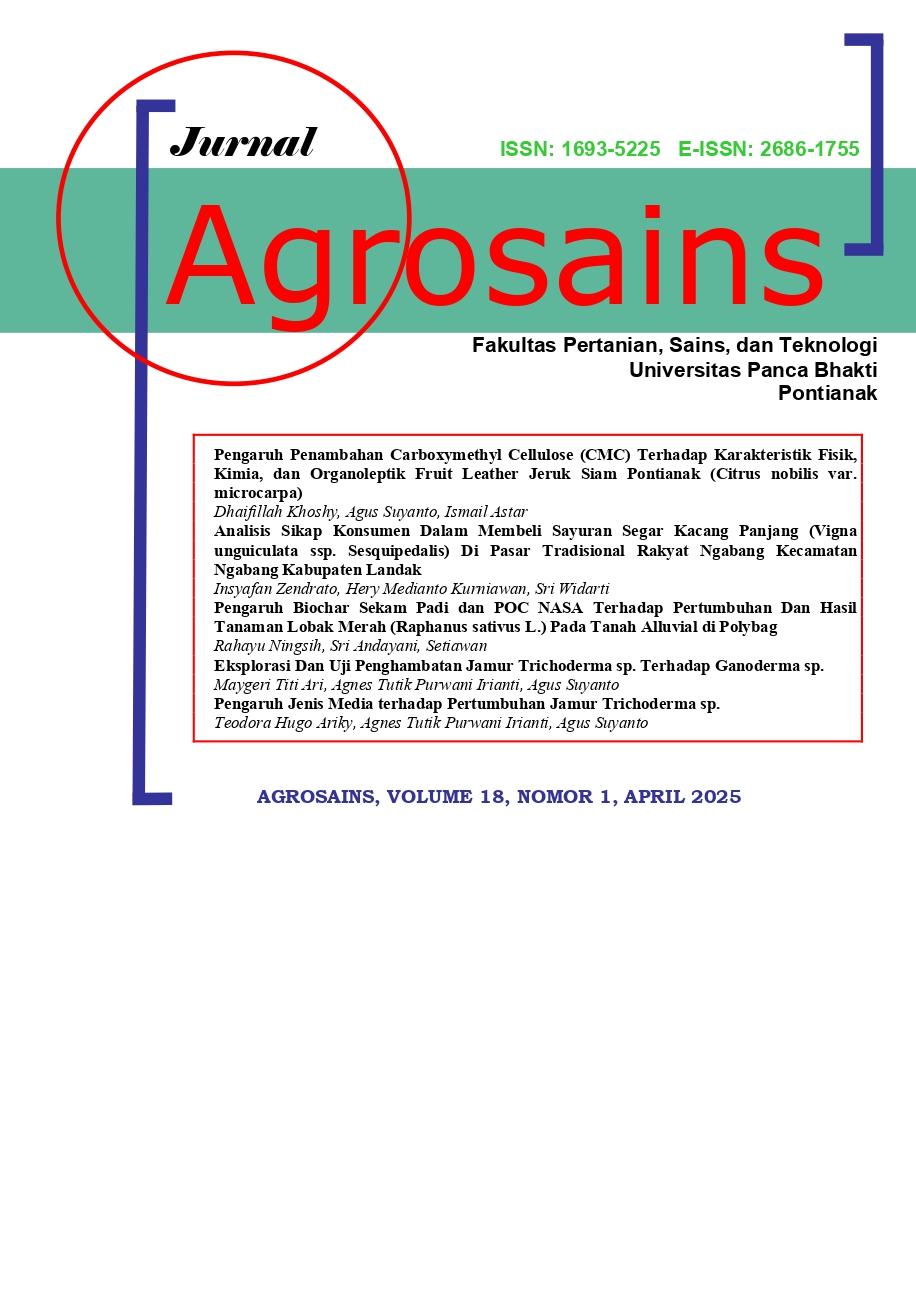Pengaruh Jenis Media terhadap Pertumbuhan Jamur Trichoderma sp.
Main Article Content
Abstract
This study aims to determine the effect of different media types on the growth of the fungus Trichoderma sp. The research was conducted at the Laboratory of the Faculty of Agriculture, Science, and Technology, Jl. Komodor Yos Sudarso No. 1, Sungai Beliung, West Pontianak District, Pontianak City, West Kalimantan. The study lasted for two months, from February 2024 to April 2024.This research employed a Completely Randomized Design (CRD) with a single factor, which was the type of media (code T), consisting of 8 treatments. The treatments were as follows: t1: Rice, t2: Corn, t3: Sugarcane Bagasse, t4: Bran, t5: Rice + Bran (1:1), t6: Corn + Bran (1:1), t7: Rice + Sugarcane Bagasse (1:1), and t8: Corn + Sugarcane Bagasse (1:1). Each treatment was repeated three times, resulting in a total of 24 experimental units. The observed variables in this study were the conidium density and viability of the Trichoderma sp. conidia. To determine the effect of the treatments on the observed variables, variance analysis (ANOVA) was performed using an F-test at a significance level of 5% and 1%. If there was a significant or highly significant effect from the treatments, it was followed by an Honest Significant Difference (HSD) test at a 5% significance level.The results of the study showed that the type of media had a highly significant effect on the conidium density and viability of the Trichoderma sp. The highest conidium density was found in treatment t8 (Corn + Sugarcane Bagasse), which was 3.27x10^9 conidia/ml, significantly different from treatments t1 (Rice), t7 (Rice + Sugarcane Bagasse), and t3 (Sugarcane Bagasse), but not significantly different from treatments t2 (Corn), t4 (Bran), t5 (Rice + Bran), and t6 (Corn + Bran). The highest spore viability of 96.8% was found in treatment t2 (Corn), significantly different from treatments t1 (Rice), t7 (Rice + Sugarcane Bagasse), t6 (Corn + Bran), and t5 (Rice + Bran), and not significantly different from treatments t4 (Bran), t8 (Corn + Sugarcane Bagasse), and t3 (Sugarcane Bagasse)
Article Details

This work is licensed under a Creative Commons Attribution-NonCommercial-NoDerivatives 4.0 International License.
References
Badan Standarisasi Nasional. (2014). Agens pengendali hayati (APH) – Bagian 3: Trichoderma sp. https://pesta.bsn.go.id
Cikita, D., Khotimah, S., & Linda, R. (2016). Uji antagonis Trichoderma sp. terhadap Phytophthora palmivora Butl. penyebab penyakit busuk buah kakao (Theobroma cacao L.). Jurnal Protobiont, 5(3).
Cook, J. R., & Baker, F. K. (1989). The nature and practice of biological control of plant pathogens. St. Paul, MN: APS Press.
Djatmiko, H. A., & Rohadi, S. S. (1997). Efektivitas Trichoderma harzianum hasil perbanyakan dalam sekam padi dan bekatul terhadap patogenesitas Plasmodiophora brassicae pada tanah Latosol dan Andosol. Majalah Ilmiah UNSOED, 2(23), 10–22.
Fitrah, Z., Suriyanti, S., & Syam, N. (2021). Uji pertumbuhan jamur Beauveria bassiana pada beberapa media pertumbuhan. Jurnal Indonesia: Jurnal Ilmu Pertanian, 2(1).
Novianti, D. (2018). Perbanyakan jamur Trichoderma sp. pada beberapa media. Sainmatika: Jurnal Ilmiah Matematika dan Ilmu Pengetahuan Alam, 15(1), 35–41.
Pracaya. (2008). Pengendalian hama dan penyakit tanaman secara organik. Yogyakarta: Kanisius.
Prajawahyudo, T., Asiaka, F. K., & Ludang, E. (2022). Peranan keamanan pestisida di bidang pertanian bagi petani dan lingkungan. Journal Socio Economics Agricultural, 17(1), 1–9.
Rosmini. (2003). Analisis risiko agens hayati untuk pengendalian patogen pada tanaman. Jurnal Litbang Pertanian.
Sinaga, M. S. (2023). Dasar-dasar ilmu penyakit tumbuhan. Jakarta: Penebar Swadaya.
Urailal, C., Kalay, A. M., Kaya, E., & Siregar, A. (2012). Pemanfaatan kompos ela sagu, sekam, dan dedak sebagai media perbanyakan agens hayati Trichoderma harzianum Rifai. Jurnal Agrologia, 1(1), 21–30.
Wijaya, I., Oktarina, & Virdanuriza, M. (2011). Pembiakan massal jamur Trichoderma sp. pada beberapa media tumbuh sebagai agen hayati pengendalian penyakit tanaman. Agritrop Jurnal Ilmu-Ilmu Pertanian. http://digilib.unmuhjember.ac.id/

